
Opinion BY Armin
Will Waterloo Logo Survive?
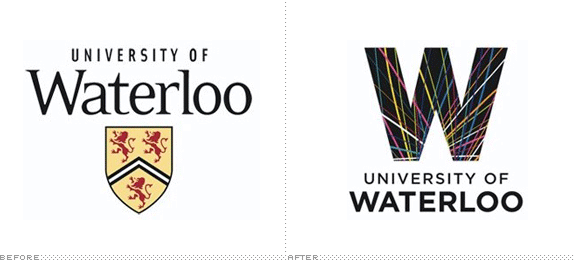
I’ve said it before and I’ll unfortunately have to say it again: Designing identities for higher education institutions is the most perilous realm of identity design and not too different from stepping right up front during Pamplona’s running of the bulls. The latest fiasco comes courtesy of the student body of the University of Waterloo in Ontario, Canada, a well regarded and large university.
Continue reading this entry

DATE: Jul.24.2009 POSTED BY: Armin
POSTED BY: Armin CATEGORY: Education
CATEGORY: Education  COMMENTS:
COMMENTS:

TAGS:

BY Armin
Punctuation University
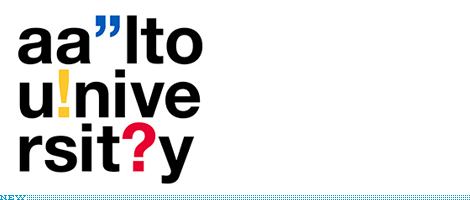
In January of 2010, Aalto University — the resulting institution of the merger of the Helsinki School of Economics, the University of Art and Design Helsinki and the Helsinki University of Technology — in Helsinki, Finland will begin its first day of school. For those interested, a handy PDF explains everything in detail about this new institution. While everything about this school indicates a forward-looking vision, they decided to hold a backwards-acting contest to determine its visual identity. Open to students, staff and alumni of Aalto University, the contest was open from March to April and a few weeks ago the winner was announced.
Continue reading this entry

DATE: Jun.01.2009 POSTED BY: Armin
POSTED BY: Armin CATEGORY: Education
CATEGORY: Education  COMMENTS:
COMMENTS:

TAGS:

BY Armin
A Tower Sheds its Stripes

Identity work for educational institutions — specially large universities — is one of the most superficially scrutinized and hardest to amicably propagate among the student body, faculty and alumni. Most people build extremely tight bonds with their institution and any change to what they remember or grew to love is always cause for dissent and, strangely enough, identity changes ignite some of the most fervent ire. The biggest complaints are always the cost, regardless of whether it’s a four, five or six figure budget and the claim that it could have easily been done in-house or by the students of the design program. Recently released, the University of Arkansas tried to quell both issues in the design of its identity by asking its office of university relations to lead the redesign in-house and letting their audience know that they would not be willing to pay top dollar for the change.
Continue reading this entry

DATE: Mar.26.2009 POSTED BY: Armin
POSTED BY: Armin CATEGORY: Education
CATEGORY: Education  COMMENTS:
COMMENTS:

TAGS:

BY Armin
Comments: The Day After
Not to dwell much longer on the subject, but just to bring some conclusions so that we can move on with our regularly scheduled posts. I have never considered our blogs to be one-way discussions where what we say is the last word, so I want to thank everyone that shared their opinion, and they are all taken into account.
Continue reading this entry

DATE: Mar.10.2009 POSTED BY: Armin
POSTED BY: Armin CATEGORY: Education
CATEGORY: Education  COMMENTS:
COMMENTS:

TAGS:

BY Armin
Cracking Down on Comment Crime
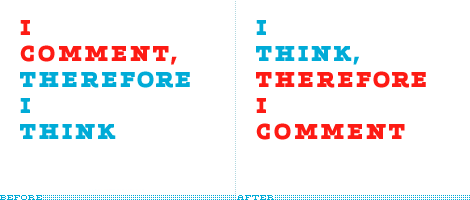
I was hoping that I would never have to write this post for Brand New, but the growing flurry of offensive and useless comments in the past few months makes it necessary. Brand New has grown into one of the most popular blogs about identity design and many, many people in the industry around the world — from interns, to creative directors, to principals — turn to us for the latest work. To their (and my own) dismay everyone is consistently disappointed by the ensuing commentary, and while some may actually enjoy the car-wreck aspect of it, it has become, in some instances, too bile and hurtful. This is unacceptable.
Continue reading this entry

DATE: Mar.09.2009 POSTED BY: Armin
POSTED BY: Armin CATEGORY: Education
CATEGORY: Education  COMMENTS:
COMMENTS:

TAGS:

BY Armin
Design = Loopy Scribble?

Formerly known as the Emily Carr Institute of Art and Design, the Emily Carr University of Art and Design — it changed its name in April of 2008 — in Vancouver is a pretty prestigious design institution with a great range of programs, and its location in Granville Island is quite groovy. So it’s no surprise that their past logo was quirky and that the new one attempts to be artsy. The latter, perhaps to a fault. Designed in-house the new logo is a loopy scribble like many other loopy scribble logos before it, and while it makes for a nice visual, it is hardly distinctive or unique for the institution. I even wonder if this has become a cliché to represent design and/or creativity. A little animation video of the logo shows that this could have had alternative potential with the light-motion technique, perhaps capturing that as a static logo would have been more interesting.
Continue reading this entry

DATE: Mar.02.2009 POSTED BY: Armin
POSTED BY: Armin CATEGORY: Education
CATEGORY: Education  COMMENTS:
COMMENTS:

TAGS:

BY Armin
I See You, C U

Comprised of the Irwin S. Chanin School of Architecture, the Albert Nerken School of Engineering, and the School of Art, New York’s The Cooper Union for the Advancement of Science and Art is one of the most prestigious colleges in the city and the country — also one of the most selective, boasting the honor of having one of the lowest acceptance rates in the nation. But those that do get in are treated to a tuition-free education. In the design industry, its School of Art is quite celebrated, with many industrious and talented alumni, including the founding members of Push Pin Studios — Seymour Chwast, Reynold Ruffins, Edward Sorel, and Milton Glaser — as well as Herb Lubalin, Lou Dorfsman, Ellen Lupton, Abbott Miller, and Stephen Doyle who just had the task of designing the identity for the 150-year-old institution.
Continue reading this entry

DATE: Feb.19.2009 POSTED BY: Armin
POSTED BY: Armin CATEGORY: Education
CATEGORY: Education  COMMENTS:
COMMENTS:

TAGS:

BY Armin
MassTerful Identity

Colleges, schools or any other educational institution devoted to design and art must, in one way or another, reflect its commitment to those areas — specifically, its identity must lead by example. Like MICA or Ringling College of Art and Design, just to name a couple we have reviewed here, MassArt is embracing the influence that a revitalized identity can have in the perception of an arts and design institution. This is specially important for a 135-year-old institution — the first and only independent public college of art in the United States, and the first art school to grant a degree — that has to compete with dozens of other schools that don’t carry the weight of more than a century.
Continue reading this entry

DATE: Mar.25.2008 POSTED BY: Armin
POSTED BY: Armin CATEGORY: Education
CATEGORY: Education  COMMENTS:
COMMENTS:

TAGS:

BY Christian Palino
A B C D E F Rand
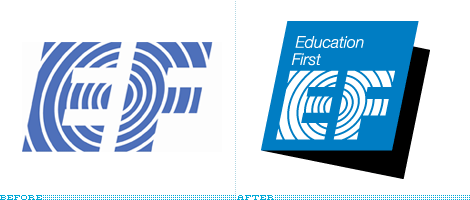
Henry Steiner, a one-time student of Paul Rand and designer of the HSBC logo, is the latest contemporary designer to alter a Paul Rand logo with a redesign for the once-named Europeiska Ferieskolan — now called Education First. Rand’s original logo was, well, a Rand design — perhaps not as superb as, say, IBM or UPS, but still smart, beautifully crafted and timeless. The redesign was commissioned to integrate “Education First” into the mark, to allow room for the product/service name to be locked-up, and to provide EF with a logo “…to represent all of our products around the world.” Steiner’s design retains the foundation of the Rand mark and executes the update around it with careful craftsmanship. When the logo is set with a product name the neutrally-toned typography finds a good visual balance. The drop shadow is an extra visual element that while not necessarily helping the semantics of the mark (it plays more contrast to the concentric circles than support) does help alleviate the blue box from being a visually flat containing shape. While, by default, I wish to keep Rand’s work from being sent to the graveyard or going under the knife, this rebranding accomplishes the goals set out by the client and at the same time retains the equity that had been established by Rand — and, at least, this logo was not subject to to gradients, shines, and bevels.

DATE: Jan.29.2008 POSTED BY: Christian Palino
POSTED BY: Christian Palino CATEGORY: Education
CATEGORY: Education  COMMENTS:
COMMENTS:

TAGS:

BY Armin
A Torch is a Terrible Thing to Waste
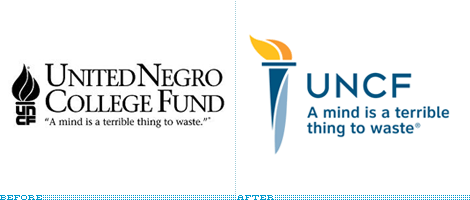
When I was younger and living in Mexico City I used to have a constant tan due to my family’s recurring vacations in the seaside town of Acapulco and the ever present sun amplified by Mexico’s choking pollution. Because of that, and because I grew up in a Jewish community where everybody’s skin hue was remarkably light, my nickname was “Negro” (pronounced, more or less, “neh-graw”) or its diminutive version, “Negrito” (“neh-gree-taw”) for closer friends. To this day, my parents still call me that. But just at home or on the phone. When I first moved to the U.S. and was working for Internet conglomerate marchFIRST, my dad was worried that during our e-mail exchanges someone scanning our correspondence would think that using the word Negro or Negrito was done in a pejorative way. In the last seven years, my lovely tan has distilled due to all the fluorescent light and lack of sunlight and, certainly, no one here in the U.S. would call me by my old nickname so it is now a thing of the past — and something that the United Negro College Fund (UNCF) hopes to achieve soon with its first major rebranding since 1972, lead by Landor Associates.
Continue reading this entry

DATE: Jan.20.2008 POSTED BY: Armin
POSTED BY: Armin CATEGORY: Education
CATEGORY: Education  COMMENTS:
COMMENTS:

TAGS:





























